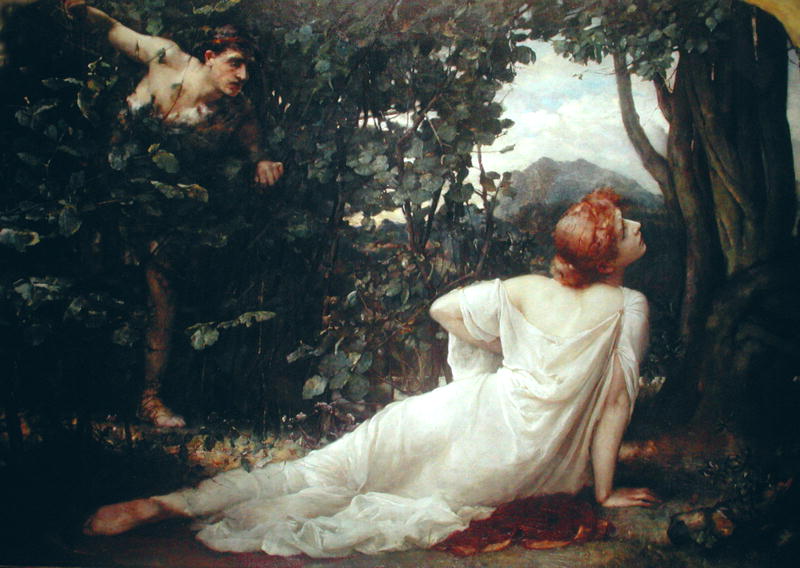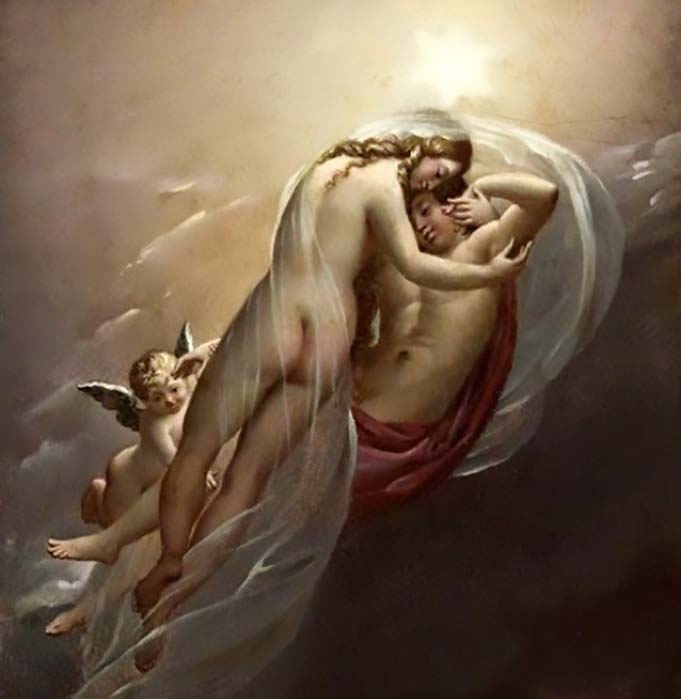
Procris

In Greek mythology, Procris (Ancient Greek: Πρόκρις) was the third daughter of Erechtheus, king of Athens and his wife, Praxithea. She married Cephalus, the son of Deioneus. Procris' sisters were Protogeneia, Pandora, Creusa, Oreithyia and Chthonia.
Sophocles wrote a tragedy called Procris which has been lost, as has a version contained in the Greek Cycle, but at least six different accounts of her story still exist.
Incest in early years
Some say that Procris, daughter of King Erechtheus of Athens, committed incest with her father, and that she then gave birth to a daughter Aglaurus.
Whom Eos carried off
Later, Procris was married to Cephalus, whom some say was carried off by Eos (Dawn). However, it is more likely that Eos abducted Cephalus, the son of Hermes and Herse, or as others say, son of Hermes and Creusa, or else she carried both of them off .
Procris's husband
Cephalus was son of Deion, son of Aeolus, son of Hellen, son of Deucalion, the man who survived the Flood; his mother was Diomede, daughter of Xuthus, brother of Aeolus. Cephalus supported Amphitryon against the Taphians, and afterwards was banished from Athens for having killed his wife.
It is said that the island of Cephallenia, which is in the Ionian Sea off the coast of Acarnania, was called after him.
Cephalus tests his wife with another man's help
Since Cephalus and Procris were bound by mutual love, they promised each other never to be untrue. But a man called Pteleon bribed her with a golden crown and was in that way admitted in her bed. Some have said that Cephalus was behind the bribe.
For he, not trusting his wife, sent this man or another to offer Procris a sum of gold on condition that she would sleep with him, and that at first she refused, but when he doubled the offer she accepted.

Cephalus tests his wife himself
Those who say that Cephalus was abducted by Eos also say that the goddess, having being refused by him because he had given his promise to Procris, said to him:
"I don't want you to break faith, unless she has done so before you." (Eos to Cephalus. Hyginus, Fabulae 189).
And so Eos turned Cephalus into a stranger, and gave him wonderful gifts to give to Procris. So when he came in his new form, he bribed his own wife with the gifts Eos had given him, and lay with her; and after making love, Cephalus recovered his normal appearance.
Procris goes to Crete
In any case, the result was that Procris was then exposed as an unfaithful wife, and being abashed or fearing her husband, she fled to Crete where the rule was held by King Minos, a man notorious for his love affairs, and for having many women.
Queen Pasiphae of Crete, however, disliking her husband's habits, had bewitched him, so that whenever Minos made love to another woman, he ejaculated serpents, scorpions, and millipeds. This circumstance did not affect the queen herself, for she, being daughter of Helius, was immortal, but all other women who had intercourse with Minos perished.
However, on account of this enchantment, Minos was unable to procreate. And that is why Procris could make a place for herself in Crete, for she promised the king to cure him, so that he could have children.
The healer Procris
And this is what Procris conceived: she introduced a goat's bladder into the genitals of a woman, so that Minos, after having discharged the beasts into the bladder, made love to Pasiphae.
This is how Minos succeeded in having descendants, and feeling grateful he gave Procris two wonderful gifts: a Swift Dog, named Laelaps, which was fated to catch whatever prey it pursued and that had been given by Zeus to Minos as a guardian for Europa (see also Amphitryon), and a Dart-That-Flew-Straight.
Procris bribed again
But others have said that Procris did not play the part of a healer in Crete, but instead that of a mistress, letting herself be seduced and bribed again. And as Minos offered her the Swift Dog and the Dart-That-Flew-Straight, she agreed to share his bed, though taking the precaution of giving him the Circaean root to drink so that he might not harm her.
Procris leaves Crete
But as this kind of affairs cannot proceed too long under the same roof, Procris, fearing Pasiphae's revenge, left Crete, taking with her the Swift Dog and the Dart-That-Flew-Straight which Minos had bribed her with, and having arrived to Athens, she became reconciled with her husband Cephalus.
Artemis behind the gifts
However, some have said that these presents were not given by Minos. For, they say, when Procris fled to Crete she met Artemis, who refused to accept her in her train because she was no longer a virgin. But when she revealed her misfortune to the goddess describing how her husband with the help of Eos had deceived her, Artemis, out of pity, gave her the Swift Dog and the Dart-That-Flew-Straight, and told her to disguise herself as a young man, go back to Athens, and contend in hunting against Cephalus.
Cephalus deluded by his wife
Having returned as a stranger, Procris met Cephalus, whom she challenged and surpassed in the hunt. When Cephalus saw that both dog and dart were irresistible, he asked the stranger to sell them to him, still not knowing that it was his wife he was bargaining with.
Procris refused several offers, but finally she said that he could get them in exchange for love. Cephalus agreed, for he no longer could control his desire for the wonderful gifts. But when they had come into the bedroom, Procris took off her tunic, and showed that she was a woman and his wife.

The bribed Cephalus takes the gifts
So Cephalus, who once had made a scheme in order to bribe his wife and corrupt her, now let himself be bribed by the same wife in disguise, who straightaway revealed her true identity. This is how Cephalus and Procris were reconciled, and Cephalus took the Dart-That-Flew-Straight and the Swift Dog.
Death of Procris
But either during this chase, or on another occasion, when Procris was in the thicket, Cephalus, not knowing she was there, threw the Dart-That-Flew-Straight at her, and killed her. Some have said that this happened when Procris, fearing that Eos would abduct Cephalus again, secretly followed her husband to watch him in the early morning, hiding herself among the bushes, and when Cephalus saw the bushes stir, he hurled the Dart-That-Flew-Straight, and being unable to miss, he killed his wife.
Cephalus banished
For this accident Cephalus was tried in the Areopagus in Athens, and condemned to perpetual banishment. Later he took part in the coalition which Amphitryon formed against the Taphians, and after the war he settled in Cephallenia, having married Clymene, daughter of Minyas.
Namesake
Procris is one of the daughters of Thespius (see Heracles), mother of Antileon and Hippeus.

Sources
Homer, Odyssee
M. Broadbent, Studies in Greek Genealogy 1968, ch. 5.
Pseudo-Apollodorus, Bibliotheca 1.9.4
Scholia ad Callimachus, Hymn, in Dian. 209
G. Daux, in L'Antiquité Classique 52 pp 150-74 and J. Paul Getty Museum 12 (1984:145-52); discussed in D. Whitehead, The demes of Attica (1986:194-99), noted by Fowler 1993.
Suida, Suda Encyclopedia s.v. Oiēthēn
E. Kearns, "The heroes of Attica" BICS Supplement 57 (1989):170.
Pseudo-Apollodorus, Bibliotheca 3.15.1
In the version of Antoninus Liberalis (§41) and Hyginus (Fabula 189), Prokris returns after her sojourn with Artemis and tests her husband disguised as a handsome youth, a late decorative embellishment interpolated to provide a further antithesis.
"Now the idea that Kephalos left his bride at the bridal chamber itself is a suspiciously particular detail", observes Robert L. Fowler, ("The myth of Kephalos as aition of rain-magic [[[Pherecydes of Athens|Pherecydes]] FrGHist 3F34]", Zeitschrift für Papyrologie und Epigraphik 97 [1993:29–42]. "The detail is there not because the narrative suggests or requires it, but because it was part of a ritual." He remarks other curious details: the return in disguise (masked?), the presentation of a gift, and above all the "summoning of a cloud".
Ovid specifies the mountaintop as Mount Hymettus; there, R.L. Fowler observes, was a sanctuary of Zeus Ombrios, bringer of rain.
Fowler 1993 represents this action as the central core of the myth, which he interprets as rain-making magic ritual; Ovid (in Ars Amatoria and also in Metamorphoses) has substituted an invocation of Aura, a cooling breeze.
Robert L. Fowler, "The myth of Kephalos as aition of rain-magic (Pherekydes FrGHist 3F34)", Zeitschrift für Papyrologie und Epigraphik 97 (1993:29–42).
P. Harvey, Oxford Companion to Classical Literature, 1937, s.v. "Cephalus," p. 96.
Greek Mythology Link, by Carlos Parada and Maicar Förlag.
Our Mobile Application
Check out Our Mobile Application "Ancient Greece Reloaded"


